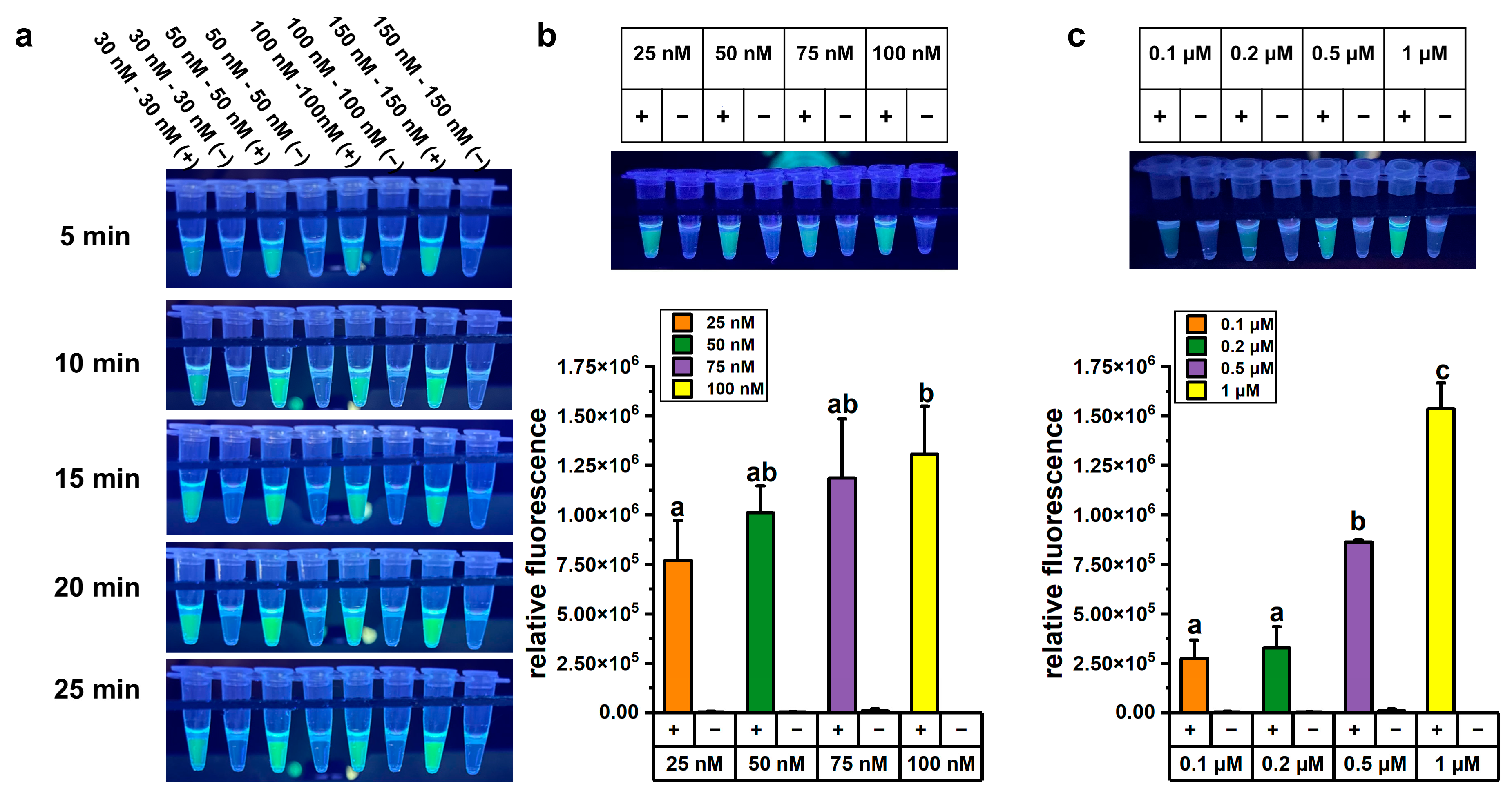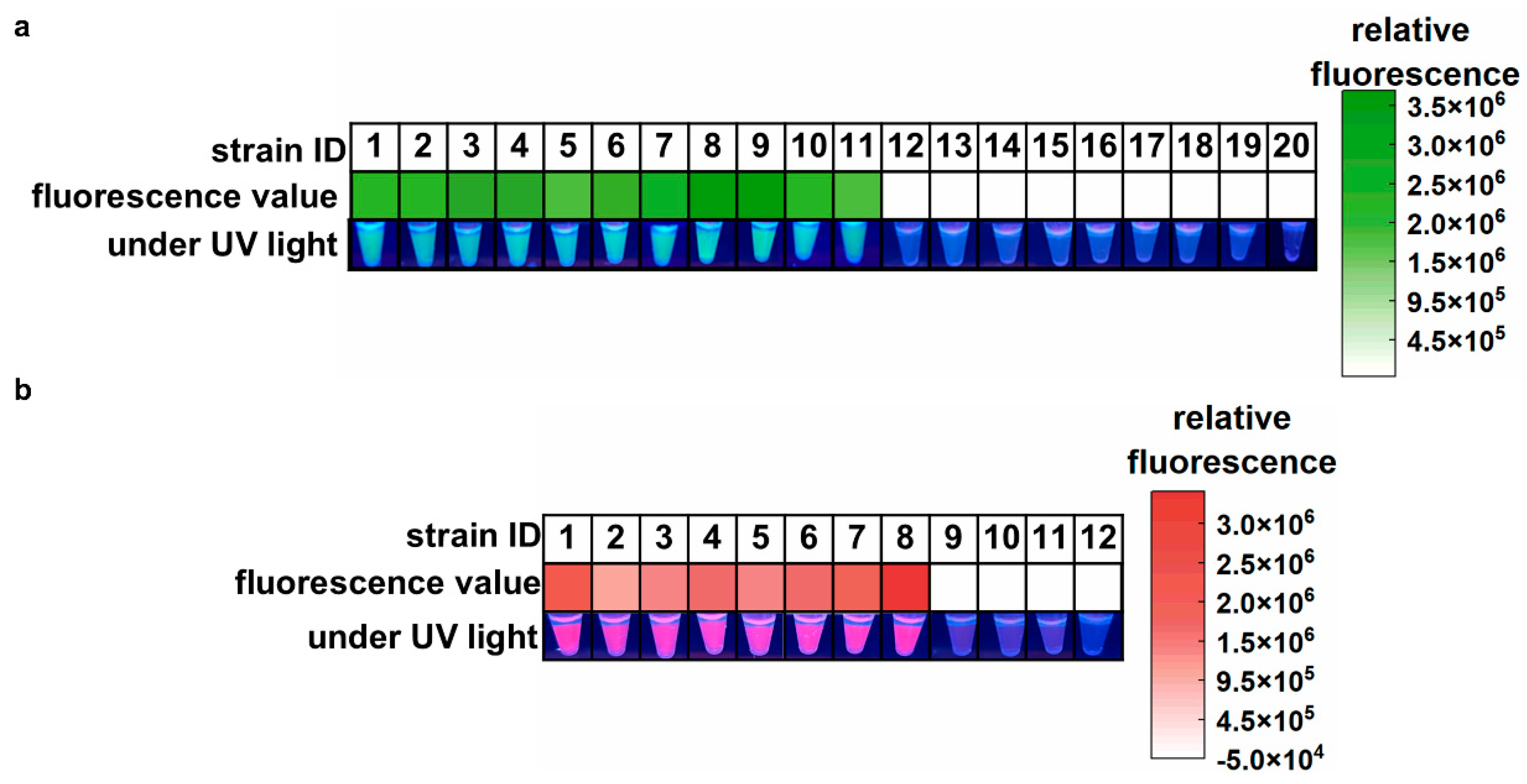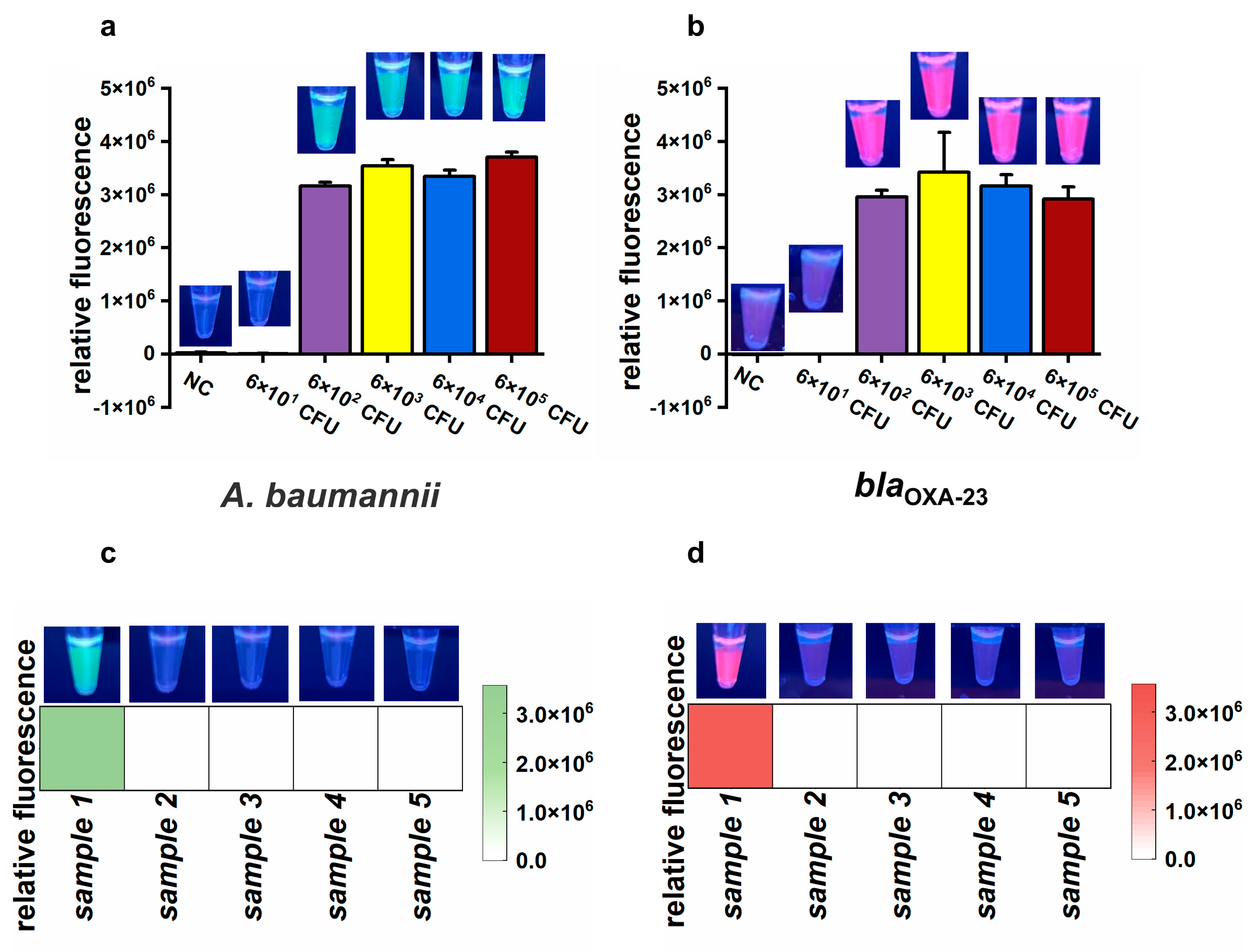On-Site Dual Detection of Airborne Acinetobacter baumannii and Its Carbapenem-Resistant Gene blaOXA-23 Using a One-Pot Visual LAMP-CRISPR/Cas12a-Based Platform
Abstract
:1. Introduction
2. Materials and Methods
2.1. Materials and Reagents
2.2. Design and Selection of Primers and crRNAs
2.3. Establishment and Optimization of One-Pot LAMP-CRISPR/Cas12a Assay
2.4. Specificity Test of the One-Pot LAMP-CRISPR/Cas12a Assay
2.5. Sensitivity Test of the One-Pot LAMP-CRISPR/Cas12a Assay
2.6. Development of a Rapid DNA Release Method for A. baumannii
2.7. Evaluation of the CLC Platform Using Simulated Air Samples
2.8. Feasibility Evaluation of the CLC Platform for Actual Air Sample Detection
3. Results
3.1. Design and Workflow of the CLC Platform for Rapid Detection of Airborne A. baumannii and blaOXA-23 Gene
3.2. Optimization of One-Pot LAMP-CRISPR/Cas12a Assay
3.3. Specificity and Feasibility of the One-Pot LAMP-CRISPR/Cas12a Assay
3.4. Sensitivity of the One-Pot LAMP-CRISPR/Cas12a Assay
3.5. Evaluation of Rapid DNA Release Methods for A. baumannii
3.6. Feasibility and Sensitivity Evaluation of the CLC Platform Using Simulated and Actual Air Samples
4. Discussion
5. Conclusions
Supplementary Materials
Author Contributions
Funding
Institutional Review Board Statement
Informed Consent Statement
Data Availability Statement
Conflicts of Interest
References
- Peleg, A.Y.; Seifert, H.; Paterson, D.L. Acinetobacter baumannii: Emergence of a successful pathogen. Clin. Microbiol. Rev. 2008, 21, 538–582. [Google Scholar] [CrossRef] [PubMed]
- Dijkshoorn, L.; Nemec, A.; Seifert, H. An increasing threat in hospitals: Multidrug-resistant Acinetobacter baumannii. Nat. Rev. Microbiol. 2007, 5, 939–951. [Google Scholar] [CrossRef] [PubMed]
- Mari-Almirall, M.; Cosgaya, C.; Higgins, P.G.; Van Assche, A.; Telli, M.; Huys, G.; Lievens, B.; Seifert, H.; Dijkshoorn, L.; Roca, I.; et al. MALDI-TOF/MS identification of species from the Acinetobacter baumannii (Ab) group revisited: Inclusion of the novel A. seifertii and A. dijkshoorniae species. Clin. Microbiol. Infect. 2017, 23, 210.e1–210.e9. [Google Scholar] [CrossRef] [PubMed]
- Sievert, D.M.; Ricks, P.; Edwards, J.R.; Schneider, A.; Patel, J.; Srinivasan, A.; Kallen, A.; Limbago, B.; Fridkin, S.; Network, N.H.S.; et al. Antimicrobial-Resistant Pathogens Associated with Healthcare-Associated Infections: Summary of Data Reported to the National Healthcare Safety Network at the Centers for Disease Control and Prevention, 2009–2010. Infect. Control Hosp. Epidemiol. 2013, 34, 1–14. [Google Scholar] [CrossRef]
- Weiner, L.M.; Webb, A.K.; Limbago, B.; Dudeck, M.A.; Patel, J.; Kallen, A.J.; Edwards, J.R.; Sievert, D.M. Antimicrobial-Resistant Pathogens Associated With Healthcare-Associated Infections: Summary of Data Reported to the National Healthcare Safety Network at the Centers for Disease Control and Prevention, 2011–2014. Infect. Control Hosp. Epidemiol. 2016, 37, 1288–1301. [Google Scholar] [CrossRef]
- World Health Organization. WHO Bacterial Priority Pathogens List, 2024: Bacterial Pathogens of Public Health Importance, to Guide Research, Development and Strategies to Prevent and Control Antimicrobial Resistance. 2024. Available online: https://iris.who.int/handle/10665/376776 (accessed on 1 December 2024).
- Lee, C.R.; Lee, J.H.; Park, M.; Park, K.S.; Bae, I.K.; Kim, Y.B.; Cha, C.J.; Jeong, B.C.; Lee, S.H. Biology of Acinetobacter baumannii: Pathogenesis, Antibiotic Resistance Mechanisms, and Prospective Treatment Options. Front. Cell Infect. Microbiol. 2017, 7, 55. [Google Scholar] [CrossRef]
- Hamidian, M.; Nigro, S.J. Emergence, molecular mechanisms and global spread of carbapenem-resistant Acinetobacter baumannii. Microb. Genom. 2019, 5, e000306. [Google Scholar] [CrossRef]
- Wong, S.C.; Lam, G.K.M.; Chen, J.H.K.; Li, X.; Ip, F.T.F.; Yuen, L.L.H.; Chan, V.W.M.; Auyeung, C.H.Y.; So, S.Y.C.; Ho, P.L.; et al. Air dispersal of multidrug-resistant Acinetobacter baumannii: Implications for nosocomial transmission during the COVID-19 pandemic. J. Hosp. Infect. 2021, 116, 78–86. [Google Scholar] [CrossRef]
- Jawad, A.; Seifert, H.; Snelling, A.M.; Heritage, J.; Hawkey, P.M. Survival of Acinetobacter baumannii on dry surfaces: Comparison of outbreak and sporadic isolates. J. Clin. Microbiol. 1998, 36, 1938–1941. [Google Scholar] [CrossRef]
- Beggs, C.B. The airbrone transmission of infection in hospital building: Fact or fioction? Indoor Built Environ. 2023, 12, 9–18. [Google Scholar] [CrossRef]
- Ghosh, B.; Lal, H.; Srivastava, A. Review of bioaerosols in indoor environment with special reference to sampling, analysis and control mechanisms. Environ. Int. 2015, 85, 254–272. [Google Scholar] [CrossRef] [PubMed]
- Dixkens, J.; Fissan, H. Development of an electrostatic precipitator for off-line particle analysis. Aerosol. Sci. Technol. 1999, 30, 438–453. [Google Scholar] [CrossRef]
- Pasquarella, C.; Pitzurra, O.; Savino, A. The index of microbial air contamination. J. Hosp. Infect. 2000, 46, 241–256. [Google Scholar] [CrossRef]
- Brandl, H. Bioaerosols in indoor environment—A review with special reference to residential and occupational locations. Open Environ. Biol. Monit. J. 2011, 4, 83–96. [Google Scholar] [CrossRef]
- Maron, P.A.; Lejon, D.P.H.; Carvalho, E.; Bizet, K.; Lemanceau, P.; Ranjard, L.; Mougel, C. Assessing genetic structure and diversity of airborne bacterial communities by DNA fingerprinting and 16S rDNA clone library. Atmos. Environ. 2005, 39, 3687–3695. [Google Scholar] [CrossRef]
- Puthussery, J.V.; Ghumra, D.P.; McBrearty, K.R.; Doherty, B.M.; Sumlin, B.J.; Sarabandi, A.; Mandal, A.G.; Shetty, N.J.; Gardiner, W.D.; Magrecki, J.P.; et al. Real-time environmental surveillance of SARS-CoV-2 aerosols. Nat. Commun. 2023, 14, 3692. [Google Scholar] [CrossRef]
- Lee, C.H.; Seok, H.; Jang, W.; Kim, J.T.; Park, G.; Kim, H.U.; Rho, J.; Kim, T.; Chung, T.D. Bioaerosol monitoring by integrating DC impedance microfluidic cytometer with wet-cyclone air sampler. Biosens. Bioelectron. 2021, 192, 113499. [Google Scholar] [CrossRef]
- Watt, A.E.; Browning, G.F.; Markham, P.F.; Marenda, M.S. Detection of naturally aerosolized Actinobacillus pleuropneumoniae on pig farms by cyclonic air sampling and qPCR. Vet. Microbiol. 2020, 250, 108856. [Google Scholar] [CrossRef]
- Heidelberg, J.F.; Shahamat, M.; Levin, M.; Rahman, I.; Stelma, G.; Grim, C.; Colwell, R.R. Effect of aerosolization on culturability and viability of gram-negative bacteria. Appl. Environ. Microb. 1997, 63, 3585–3588. [Google Scholar] [CrossRef]
- Hospodsky, D.; Yamamoto, N.; Peccia, J. Accuracy, precision, and method detection limits of quantitative pcr for airborne bacteria and fungi. Appl. Environ. Microb. 2010, 76, 7004–7012. [Google Scholar] [CrossRef]
- Rashid, S.A.; Nazakat, R.; Robat, R.M.; Ismail, R.; Suppiah, J.; Rajendran, K.; Masalamany, A.S.S.R.L.; Hendri, N.A.M.; Mohamad, N.; Hasni, N.A.K.; et al. Droplet digital PCR application for the detection of SARS-CoV-2 in air sample. Front. Public Health 2023, 11, 1208348. [Google Scholar] [CrossRef] [PubMed]
- Lee, S.; Khoo, V.S.L.; Medriano, C.A.D.; Lee, T.; Park, S.Y.; Bae, S. Rapid and in-situ detection of fecal indicator bacteria in water using simple DNA extraction and portable loop-mediated isothermal amplification (LAMP) PCR methods. Water Res. 2019, 160, 371–379. [Google Scholar] [CrossRef] [PubMed]
- Kim, Y.-J.; Lee, J.-I.; Kang, D.-H. Inactivation of foodborne pathogenic bacteria in water and stainless steel surfaces by vacuum-UV amalgam lamp and low-pressure mercury UV lamp irradiation. Innov. Food Sci. Emerg. Technol. 2023, 84, 103297. [Google Scholar] [CrossRef]
- Peng, Z.; Tan, X.; Liu, M.; Deng, J.; Gong, S.; Gao, Y.; Li, D.; Zhang, J.; Ruan, C.; Sun, W.; et al. Rapid detection of frogeye leaf spot pathogen in seeds by LAMP assays to protect soybean production. Plant Dis. 2025. [Google Scholar] [CrossRef]
- Liu, Q.; Zhang, X.; Yao, Y.; Jing, W.; Liu, S.; Sui, G. A novel microfluidic module for rapid detection of airborne and waterborne pathogens. Sens. Actuators B Chem. 2018, 258, 1138–1145. [Google Scholar] [CrossRef]
- Jiang, X.; Jing, W.; Sun, X.; Liu, Q.; Yang, C.; Liu, S.; Qin, K.; Sui, G. High-Throughput Microfluidic Device for LAMP Analysis of Airborne Bacteria. ACS Sens. 2016, 1, 958–962. [Google Scholar] [CrossRef]
- Wang, R.; Qian, C.; Pang, Y.; Li, M.; Yang, Y.; Ma, H.; Zhao, M.; Qian, F.; Yu, H.; Liu, Z.; et al. opvCRISPR: One-pot visual RT-LAMP-CRISPR platform for SARS-CoV-2 detection. Biosens. Bioelectron. 2021, 172, 112766. [Google Scholar] [CrossRef]
- Zhang, T.; Zhao, W.; Zhao, W.; Si, Y.; Chen, N.; Chen, X.; Zhang, X.; Fan, L.; Sui, G. Universally Stable and Precise CRISPR-LAMP Detection Platform for Precise Multiple Respiratory Tract Virus Diagnosis Including Mutant SARS-CoV-2 Spike N501Y. Anal. Chem. 2021, 93, 16184–16193. [Google Scholar] [CrossRef]
- Walsh, P.S.; Metzger, D.A.; Higuchi, R. Chelex-100 as a medium for simple extraction of DNA for PCR-based typing from forensic material. Biotechniques 1991, 10, 506–513. [Google Scholar] [CrossRef]
- Singh, U.A.; Kumari, M.; Iyengar, S. Method for improving the quality of genomic DNA obtained from minute quantities of tissue and blood samples using Chelex 100 resin. Biol. Proced. Online 2018, 20, 12. [Google Scholar] [CrossRef]
- Zou, Z.; Guo, L.N.; Ahmadi, P.; Hartjen, P.; Gosau, M.; Smeets, R.; Kluwe, L. Two simple and inexpensive methods for preparing DNA suitable for digital PCR from a small number of cells in 96-well plates. J. Clin. Lab. Anal. 2021, 35, e23513. [Google Scholar] [CrossRef] [PubMed]
- Yang, J.N.; Hu, X.J.; Wang, W.Z.; Yang, Y.J.; Zhang, X.Q.; Fang, W.; Zhang, L.; Li, S.; Gu, B. RT-LAMP assay for rapid detection of the R203M mutation in SARS-CoV-2 Delta variant. Emerg. Microbes Infect. 2022, 11, 978–987. [Google Scholar] [CrossRef]
- Lee, S.Y.; Oh, S.W. Filtration-based LAMP-CRISPR/Cas12a system for the rapid, sensitive and visualized detection of Escherichia coli O157:H7. Talanta 2022, 241, 123186. [Google Scholar] [CrossRef] [PubMed]
- Wu, B.; Tong, X.X.; Chen, B.; Yuan, W.C.; Fu, M.P.; Yang, X.; Chen, H.L.; Zhang, G.H.; Wu, G.J.; Xu, B.L. Development of microfluidic chip-based loop-mediated isothermal amplification (LAMP) method for detection of carbapenemase producing bacteria. Microbiol. Spectr. 2022, 10, e0032222. [Google Scholar] [CrossRef] [PubMed]
- Dixit, K.K.; Verma, S.; Singh, O.P.; Singh, D.; Singh, A.P.; Gupta, R.; Negi, N.S.; Das, P.; Sundar, S.; Singh, R.; et al. Validation of SYBR green I based closed tube loop mediated isothermal amplification (LAMP) assay and simplified direct-blood-lysis (DBL)-LAMP assay for diagnosis of visceral leishmaniasis (VL). PLoS Negl. Trop D 2018, 12, e0006922. [Google Scholar] [CrossRef]
- Goto, M.; Honda, E.; Ogura, A.; Nomoto, A.; Hanaki, K.I. Colorimetric detection of loop-mediated isothermal amplification reaction by using hydroxy naphthol blue. Biotechniques 2009, 46, 167–172. [Google Scholar] [CrossRef]
- Tomita, N.; Mori, Y.; Kanda, H.; Notomi, T. Loop-mediated isothermal amplification (LAMP) of gene sequences and simple visual detection of products. Nat. Protoc. 2008, 3, 877–882. [Google Scholar] [CrossRef]
- Wang, L.; Zhao, P.; Si, X.; Li, J.; Dai, X.; Zhang, K.; Gao, S.; Dong, J. Rapid and specific detection of Listeria monocytogenes with an isothermal amplification and lateral flow strip combined method that eliminates false-positive signals from primer-dimers. Front. Microbiol. 2019, 10, 2959. [Google Scholar] [CrossRef]
- Dong, D.; Liu, W.; Li, H.; Wang, Y.; Li, X.; Zou, D.; Yang, Z.; Huang, S.; Zhou, D.; Huang, L.; et al. Survey and rapid detection of Klebsiella pneumoniae in clinical samples targeting the rcsA gene in Beijing, China. Front. Microbiol. 2015, 6, 519. [Google Scholar] [CrossRef]
- Li, S.-Y.; Cheng, Q.-X.; Liu, J.-K.; Nie, X.-Q.; Zhao, G.-P.; Wang, J. CRISPR-Cas12a has both cis- and trans-cleavage activities on single-stranded DNA. Cell Res. 2018, 28, 491–493. [Google Scholar] [CrossRef]
- Chen, J.S.; Ma, E.B.; Harrington, L.B.; Da Costa, M.; Tian, X.R.; Palefsky, J.M.; Doudna, J.A. CRISPR-Cas12a target binding unleashes indiscriminate single-stranded DNase activity. Science 2018, 360, 436–439. [Google Scholar] [CrossRef] [PubMed]
- Joshi, P.R.; Acharya, M.; Kakshapati, T.; Leungtongkam, U.; Thummeepak, R.; Sitthisak, S. Co-existence of blaOXA-23 and blaNDM-1 genes of Acinetobacter baumannii isolated from Nepal: Antimicrobial resistance and clinical significance. Antimicrob. Resist. Infect. Control 2017, 6, 21. [Google Scholar] [CrossRef] [PubMed]
- Findlay, J.; Nordmann, P.; Bouvier, M.; Kerbol, A.; Poirel, L. Dissemination of ArmA- and OXA-23-co-producing Acinetobacter baumannii Global Clone 2 in Switzerland, 2020–2021. Eur. J. Clin. Microbiol. Infect. Dis. 2023. [Google Scholar] [CrossRef]
- Raddaoui, A.; Mabrouk, A.; Chebbi, Y.; Frigui, S.; Salah Abbassi, M.; Achour, W.; Thabet, L. Co-occurrence of blaNDM-1 and blaOXA-23 in carbapenemase-producing Acinetobacter baumannii belonging to high-risk lineages isolated from burn patients in Tunisia. J. Appl. Microbiol. 2024, 135, lxae039. [Google Scholar] [CrossRef]
- Wang, H.; Guo, P.; Sun, H.; Wang, H.; Yang, Q.; Chen, M.; Xu, Y.; Zhu, Y. Molecular epidemiology of clinical isolates of carbapenem-resistant Acinetobacter spp. from Chinese hospitals. Antimicrob. Agents Chemother. 2007, 51, 4022–4028. [Google Scholar] [CrossRef]
- Li, S.Y.; Cheng, Q.X.; Wang, J.M.; Li, X.Y.; Zhang, Z.L.; Gao, S.; Cao, R.B.; Zhao, G.P.; Wang, J. CRISPR-Cas12a-assisted nucleic acid detection. Cell Discov. 2018, 4, 20. [Google Scholar] [CrossRef]
- Luo, J.; Liu, M.; Wang, P.; Li, Q.; Luo, C.; Wei, H.; Hu, Y.; Yu, J. Evaluation of a direct phage DNA detection-based Taqman qPCR methodology for quantification of phage and its application in rapid ultrasensitive identification of Acinetobacter baumannii. BMC Infect. Dis. 2022, 22, 523. [Google Scholar] [CrossRef]
- Esmaeeli, A.; Ravan, H.; Hassanshahian, M.; Khaleghi, M. Rapid LAMP-based detection of A. baumannii and aminoglycoside resistance genes in ESKAPE pathogens. Microb. Pathog. 2025, 202, 107436. [Google Scholar] [CrossRef]
- Chen, T.L.; Siu, L.K.; Wu, R.C.; Shaio, M.F.; Huang, L.Y.; Fung, C.P.; Lee, C.M.; Cho, W.L. Comparison of one-tube multiplex PCR, automated ribotyping and intergenic spacer (ITS) sequencing for rapid identification of Acinetobacter baumannii. Clin. Microbiol. Infect. 2007, 13, 801–806. [Google Scholar] [CrossRef]
- Kanapathy, S.; Obande, G.A.; Chuah, C.; Shueb, R.H.; Yean, C.Y.; Banga Singh, K.K. Sequence-Specific Electrochemical Genosensor for Rapid Detection of bla(OXA-51-like) Gene in Acinetobacter baumannii. Microorganisms 2022, 10, 1413. [Google Scholar] [CrossRef]
- Bai, Y.L.; Shahed-Al-Mahmud, M.; Selvaprakash, K.; Lin, N.T.; Chen, Y.C. Tail Fiber Protein-Immobilized Magnetic Nanoparticle-Based Affinity Approaches for Detection of Acinetobacter baumannii. Anal. Chem. 2019, 91, 10335–10342. [Google Scholar] [CrossRef] [PubMed]
- Zhou, Z.; Liang, L.; Liao, C.; Pan, L.; Wang, C.; Ma, J.; Yi, X.; Tan, M.; Li, X.; Wei, G. A multiplex RPA coupled with CRISPR-Cas12a system for rapid and cost-effective identification of carbapenem-resistant Acinetobacter baumannii. Front. Microbiol. 2024, 15, 1359976. [Google Scholar] [CrossRef]
- Kou, X.; Zhu, D.; Zhang, Y.; Huang, L.; Liang, J.; Wu, Z.; Liu, Z.; Guan, C.; Yu, L. Development and clinical validation of a dual ddPCR assay for detecting carbapenem-resistant Acinetobacter baumannii in bloodstream infections. Front. Microbiol. 2024, 15, 1338395. [Google Scholar] [CrossRef] [PubMed]
- Yu, L.; Kou, X.; Liu, Z.; Guan, C.; Sun, B. Establishment and validation of a dual qPCR method for the detection of carbapenem-resistant Acinetobacter baumannii in bloodstream infections. Front. Cell Infect. Microbiol. 2025, 15, 1490528. [Google Scholar] [CrossRef] [PubMed]
- Kim, H.J.; Kim, H.S.; Lee, J.M.; Yoon, S.S.; Yong, D. Rapid detection of Pseudomonas aeruginosa and Acinetobacter baumannii Harboring bla(VIM-2), bla(IMP-1) and bla(OXA-23) genes by using loop-mediated isothermal amplification methods. Ann. Lab. Med. 2016, 36, 15–22. [Google Scholar] [CrossRef]






Disclaimer/Publisher’s Note: The statements, opinions and data contained in all publications are solely those of the individual author(s) and contributor(s) and not of MDPI and/or the editor(s). MDPI and/or the editor(s) disclaim responsibility for any injury to people or property resulting from any ideas, methods, instructions or products referred to in the content. |
© 2025 by the authors. Licensee MDPI, Basel, Switzerland. This article is an open access article distributed under the terms and conditions of the Creative Commons Attribution (CC BY) license (https://creativecommons.org/licenses/by/4.0/).
Share and Cite
Lu, H.; Zhang, T.; Huang, W.; Zhu, J.; Qin, H.; Chen, X.; Zhao, W.; Sui, G. On-Site Dual Detection of Airborne Acinetobacter baumannii and Its Carbapenem-Resistant Gene blaOXA-23 Using a One-Pot Visual LAMP-CRISPR/Cas12a-Based Platform. Microorganisms 2025, 13, 976. https://doi.org/10.3390/microorganisms13050976
Lu H, Zhang T, Huang W, Zhu J, Qin H, Chen X, Zhao W, Sui G. On-Site Dual Detection of Airborne Acinetobacter baumannii and Its Carbapenem-Resistant Gene blaOXA-23 Using a One-Pot Visual LAMP-CRISPR/Cas12a-Based Platform. Microorganisms. 2025; 13(5):976. https://doi.org/10.3390/microorganisms13050976
Chicago/Turabian StyleLu, Huijun, Tong Zhang, Wei Huang, Jinhui Zhu, Haoran Qin, Xi Chen, Wang Zhao, and Guodong Sui. 2025. "On-Site Dual Detection of Airborne Acinetobacter baumannii and Its Carbapenem-Resistant Gene blaOXA-23 Using a One-Pot Visual LAMP-CRISPR/Cas12a-Based Platform" Microorganisms 13, no. 5: 976. https://doi.org/10.3390/microorganisms13050976
APA StyleLu, H., Zhang, T., Huang, W., Zhu, J., Qin, H., Chen, X., Zhao, W., & Sui, G. (2025). On-Site Dual Detection of Airborne Acinetobacter baumannii and Its Carbapenem-Resistant Gene blaOXA-23 Using a One-Pot Visual LAMP-CRISPR/Cas12a-Based Platform. Microorganisms, 13(5), 976. https://doi.org/10.3390/microorganisms13050976




